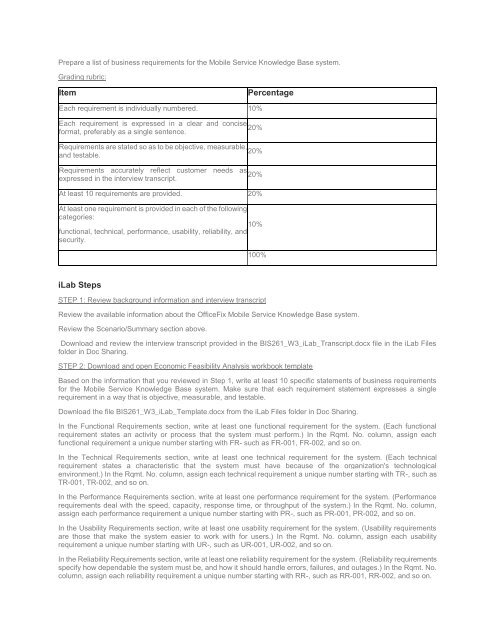BIS 261 DeVry Week 3 I Lab Latest
You also want an ePaper? Increase the reach of your titles
YUMPU automatically turns print PDFs into web optimized ePapers that Google loves.
Prepare a list of business requirements for the Mobile Service Knowledge Base system.<br />
Grading rubric:<br />
Item<br />
Percentage<br />
Each requirement is individually numbered. 10%<br />
Each requirement is expressed in a clear and concise<br />
20%<br />
format, preferably as a single sentence.<br />
Requirements are stated so as to be objective, measurable,<br />
20%<br />
and testable.<br />
Requirements accurately reflect customer needs as<br />
20%<br />
expressed in the interview transcript.<br />
At least 10 requirements are provided. 20%<br />
At least one requirement is provided in each of the following<br />
categories:<br />
functional, technical, performance, usability, reliability, and<br />
security.<br />
10%<br />
100%<br />
i<strong>Lab</strong> Steps<br />
STEP 1: Review background information and interview transcript<br />
Review the available information about the OfficeFix Mobile Service Knowledge Base system.<br />
Review the Scenario/Summary section above.<br />
Download and review the interview transcript provided in the <strong>BIS</strong><strong>261</strong>_W3_i<strong>Lab</strong>_Transcript.docx file in the i<strong>Lab</strong> Files<br />
folder in Doc Sharing.<br />
STEP 2: Download and open Economic Feasibility Analysis workbook template<br />
Based on the information that you reviewed in Step 1, write at least 10 specific statements of business requirements<br />
for the Mobile Service Knowledge Base system. Make sure that each requirement statement expresses a single<br />
requirement in a way that is objective, measurable, and testable.<br />
Download the file <strong>BIS</strong><strong>261</strong>_W3_i<strong>Lab</strong>_Template.docx from the i<strong>Lab</strong> Files folder in Doc Sharing.<br />
In the Functional Requirements section, write at least one functional requirement for the system. (Each functional<br />
requirement states an activity or process that the system must perform.) In the Rqmt. No. column, assign each<br />
functional requirement a unique number starting with FR- such as FR-001, FR-002, and so on.<br />
In the Technical Requirements section, write at least one technical requirement for the system. (Each technical<br />
requirement states a characteristic that the system must have because of the organization's technological<br />
environment.) In the Rqmt. No. column, assign each technical requirement a unique number starting with TR-, such as<br />
TR-001, TR-002, and so on.<br />
In the Performance Requirements section, write at least one performance requirement for the system. (Performance<br />
requirements deal with the speed, capacity, response time, or throughput of the system.) In the Rqmt. No. column,<br />
assign each performance requirement a unique number starting with PR-, such as PR-001, PR-002, and so on.<br />
In the Usability Requirements section, write at least one usability requirement for the system. (Usability requirements<br />
are those that make the system easier to work with for users.) In the Rqmt. No. column, assign each usability<br />
requirement a unique number starting with UR-, such as UR-001, UR-002, and so on.<br />
In the Reliability Requirements section, write at least one reliability requirement for the system. (Reliability requirements<br />
specify how dependable the system must be, and how it should handle errors, failures, and outages.) In the Rqmt. No.<br />
column, assign each reliability requirement a unique number starting with RR-, such as RR-001, RR-002, and so on.

















